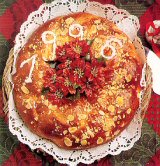Catholic Recipe: Basilopitta

Also Called: St. Basil's Cake; St. Basil's Day Bread
The New Year follows Jesus' birth. May Jesus Christ, who walks this earth, Bless you this night, This new month's eve, This New Year's Eve, And fill your hearts with joy, And fill your hearts with joy.
This is the song Greek carolers sing on Saint Basil's Eve, the last night of the year, as they roam the villages and beg for coins. The pieces of money jingle into a toy ship — "Saint Basil's ship," the singers call it, after Basil the Great, fourth-century Bishop of Caesarea and a Greek Church Father. The itinerant minstrels sing nonsense rhymes that include references to Saint Basil's "sugar candies sweet and bright" and to the pen he carries to write fortunes.
In popular thinking Saint Basil is indeed a fortune-telling saint. According to old custom, Greek families, wherever they are, celebrate January first, anniversary of Saint Basil's death, by cutting a special divination cake. The basilopitta, or cake of Saint Basil, is round and flat. In it are hidden a coin and other symbols. Whoever finds the money-formerly silver for the poor and gold for the well-to-do-will be prosperous throughout the coming year. Other tokens in the basilopitta prophesy the future occupations or interests of each member of the company. In the country, a few generations ago, a grapevine twig stood for the ancestral vineyard, a straw and a dwarf-oak leaf for the cows and goats that feed on them, and an osier circlet for sheep. A cross of green was for the home, a purse for prosperity, and a ring for marriage.
The mistress of the house traditionally makes the basilopitta. Once she wore her most elaborate costume and finest gold ornaments when she mixed the ingredients, for the task is ritualistic. Ancient custom prescribed the division of the cake.
In certain areas it is customary to cut a round piece in the center of the cake for Saint Basil. The other helpings radiate from this circle. And since nobody may witness the cake's division, it is done under a napkin. The first piece goes to the eldest member of the group, the last to the youngest.
Legend says the basilopitta originated during the time Saint Basil was Bishop of Caesarea. The governor of the district sent word that he intended to visit. The townsfolk trembled, for the governor was cruel and avaricious and the people wished to flee. Saint Basil persuaded them, instead, to greet the unwelcome guest at the city gates with gifts of precious gems, rings, and ornaments of silver and gold.
The people did as Saint Basil commanded. Their apparent warmth and generosity flattered the governor and he refused to accept the treasure laid at his feet. Instead of plundering the city, he peacefully went his way.
The Caesareans were jubilant, but the saint was worried. How, from the great heap of treasure could he ever return to each man his rightful possession? Finally, he decided to make small cakes and put a single jewel or trinket in each.
After a great Thanksgiving Mass, Saint Basil distributed the cakes and, miraculously, each man received his own treasure. To commemorate this miracle, Greeks make cakes every New Year in which they hide coins, good luck tokens or charms to prophesy the future.
Why not make a Saint Basil mystery cake for your New Year's Eve party? Kurabeeyah — a kind of Greek shortbread — makes a wonderful basilopitta. It is rich but not sweet-just right with eggnog or sherry or coffee, chocolate, or tea. Make the cake large and round. Serve it plain, with confectioners' sugar over the top; or decorate it elaborately with colored frostings; or with a pleasing design of candied fruits and blanched almond halves.
Wrap fortune symbols in waxed paper and press them into the unbaked dough. To give the party added sparkle, accompany the favors with appropriate rhymes to be read aloud. Use familiar symbols such as a dime for prosperity, a penny for poverty, a button for a bachelor, a rubber band for a snappy life, and so on. Or get small silver charms if you wish to give more lasting mementos.
The secret of this cake depends largely upon long mixing and kneading. Greek housewives say you must work the ingredients together for an hour. You may do this in ten- or fifteen-minute shifts. The fine texture of the resulting product justifies the time spent in preparation.
DIRECTIONS
Cream butter thoroughly, add sugar, egg yolk, flavoring, and mix. Sift together flour and baking powder and add gradually, mixing well after each addition. Work all the ingredients together with the fingers for 60 minutes. Press dough into 10-inch round pan. Sink wax-paper-wrapped trinkets into dough. Smooth top and prick with tines of fork. Bake in moderate oven (350º F.) approximately 25 minutes, or until delicately browned. Cool 10 minutes before removing from pan. Decorate as desired.
In serving, cut a circle in the center of the cake with a tumbler. Cut the other pieces to radiate from this circle.
If individual cakes are desired, roll or press out dough to 1/2-inch thickness; cut in circle, diamond, heart, or crescent shapes, decorate with chopped blanched almonds, candied cherries, or small colored candies, and bake until delicately browned.
Recipe Source: Feast-Day Cakes from Many Lands by Dorothy Gladys Spicer, Holt, Rinehart and Winston, 1960





